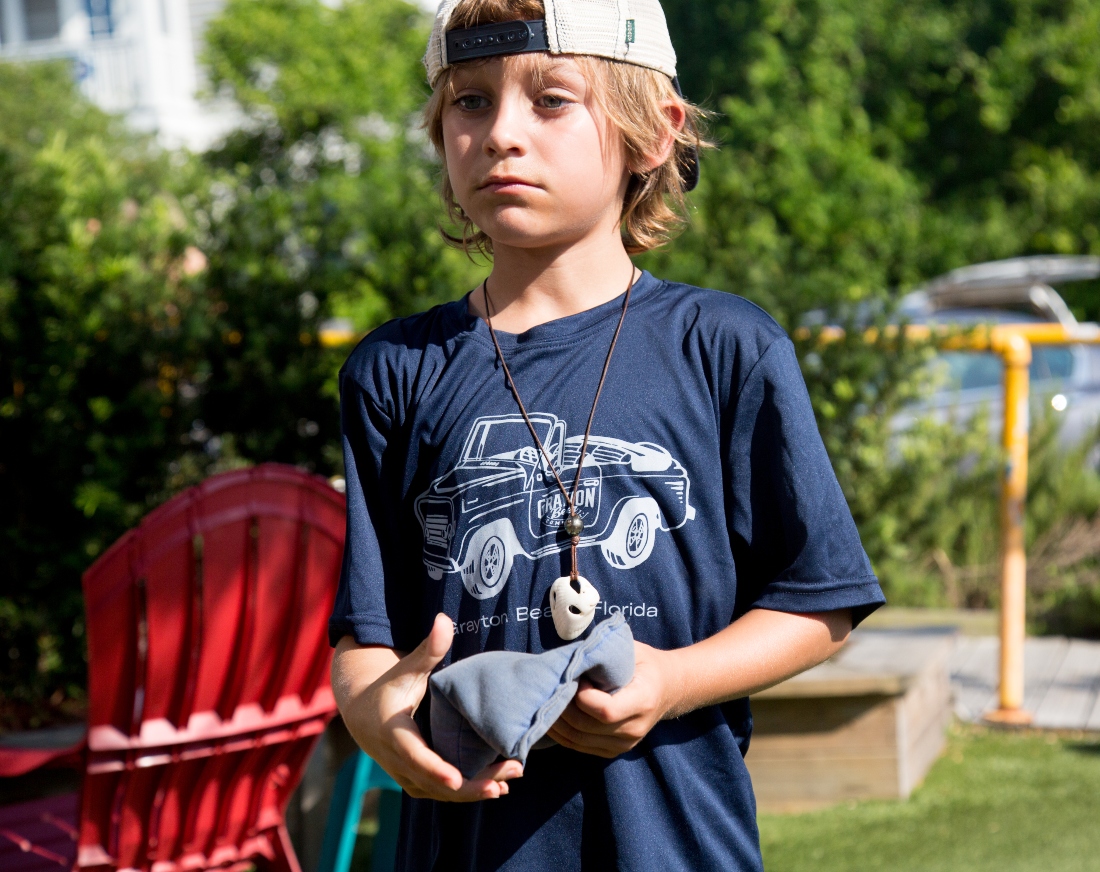


Editor’s Note: special thanks to Jason Williams for his exceptional craftsmanship in creating the cornhole boards that have elevated the game to a whole new level.
Picture a warm summer day, the sun shining brightly, the aroma of barbecue wafting through the salt air, and the cheerful laughter of friends and family gathered on the sand. Amidst this idyllic scene, there’s a good chance you’ll find a friendly game of cornhole in progress, with players of all ages taking turns tossing bean bags at a wooden target. But have you ever wondered how this simple yet addictive game came to be?
Let’s dive into the fascinating history of cornhole and explore its rise to popularity as a staple of American leisure.

Cornhole – also known as bean bag toss, sack toss, or baggo – is a popular beach and backyard game with a history that is both debated and somewhat murky.
The basic premise of the game is to toss small bean bags or corn-filled bags onto a raised wooden platform with a hole in the far end, aiming to get the bags into the hole or as close as possible. The game is typically played in a 2-vs-2 format, with players taking turns tossing their bags.
There are numerous theories regarding the origin of cornhole.
Some sources suggest that cornhole can be traced back to 14th-century Germany, where the game was played using rocks and a hole dug in the ground. The game supposedly evolved over time, and settlers brought a variant of it to the United States. Another theory posits that cornhole originated from a Native American game called Hubbub, which involved tossing beans or corn kernels into a hole in the ground. Some believe that European settlers adapted the game, leading to the modern version of cornhole. Another Native American connection involves the Blackhawk tribe in Illinois, who reportedly filled pig bladders with dried beans and tossed them into holes as a form of entertainment. As with the Hubbub theory, it is thought that European settlers adapted this game into the cornhole we know today.
While the historical origins of cornhole may be shrouded in mystery, there’s no denying the pivotal role that Cincinnati, Ohio, played in the game’s recent resurgence. In the early 2000s, cornhole’s popularity skyrocketed in the Midwest, with Cincinnati earning the unofficial title of “Cornhole Capital of the World.” The founding of the American Cornhole Association in 2003 further solidified the game’s status as a legitimate pastime, complete with official rules, regulations, and even organized tournaments.

Photo credit: Grayton Beer
One of the secrets to cornhole’s enduring appeal is its accessibility. With a simple set of rules and minimal equipment required, the game can be enjoyed by young and old alike, making it the perfect addition to any gathering.
Whether it’s a family reunion, a neighborhood barbecue, or a competitive tailgate party, cornhole offers an inviting and inclusive way for people to bond and engage in friendly competition.
Cornhole’s popularity has extended far beyond casual backyard and beach games. Today, the sport boasts a thriving competitive scene, with amateur and professional leagues hosting tournaments throughout the country. Additionally, the game has spawned a variety of creative variations and themed sets, ranging from personalized boards featuring favorite sports teams to glow-in-the-dark options for nighttime play.
The journey of cornhole from its mysterious beginnings to its current status as a beloved American pastime is a testament to the game’s irresistible charm. With its simple rules, easy setup, and universal appeal, cornhole has cemented its place in the pantheon of classic lawn games. So, the next time you find yourself at a sun-soaked gathering with bean bags in hand, take a moment to appreciate the storied history of this timeless game – and, of course, aim for the hole!
While the concept of Cornhole is simple, enthusiasts can spend more than a few kernels to get in the hole.
Regulation Cornhole Boards: These are the standard-sized boards used for official games, typically measuring 4′ x 2′ with a 6-inch hole. Prices can range from $80 to $300, depending on the materials and design.
All-Weather Cornhole Boards: These boards are made from materials that can withstand harsh weather conditions, making them ideal for outdoor play. Prices vary but expect to pay anywhere from $100 to $350.
Cornhole Bags: Regulation cornhole bags are 6″ x 6″ and filled with 16 ounces of corn kernels or synthetic pellets. Prices for a set of eight bags can range from $20 to $50, depending on the materials.
Custom Cornhole Boards: Many retailers offer customizable boards with unique designs, team logos, or personalized graphics. Prices for custom boards can vary greatly, with some options starting around $150 and going up to $500 or more.
Cornhole Carrying Cases: These cases make it easy to transport and store your cornhole boards and bags. Prices for carrying cases can range from $20 to $60, depending on the size and quality.

Whether you’re a seasoned cornhole pro or a newcomer to this addictive pastime, here’s a quick rundown of the essentials you need to know before you toss your first bean bag:
Equipment
Two cornhole boards, each with a 6-inch hole, spaced 27 feet apart (from the front edges). Eight bean bags (four of each color, usually filled with corn kernels or synthetic pellets).
Players
Cornhole is typically played with two teams of two players each. Opposing team members stand at opposite cornhole boards.
Gameplay
Teams take turns tossing bean bags, with each player throwing one bag per turn. The objective is to land the bean bags on the board (1 point) or through the hole (3 points). Players can knock opponents’ bags off the board or use their own bags to push others into the hole.
Scoring
After all eight bags have been thrown in a round (four per team), the points are tallied. Only one team scores per round, earning the difference in points between the two teams. (Example: If Team A scores 5 points and Team B scores 3 points, Team A earns 2 points for that round.)
Winning
The game continues until one team reaches or exceeds 21 points. A team must win by at least 2 points, so the score is 21–20, the game continues until this condition is met.


